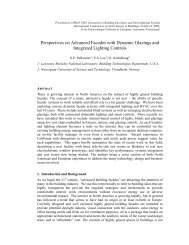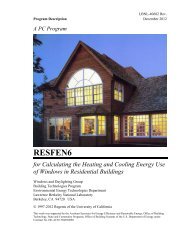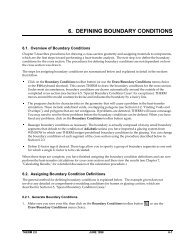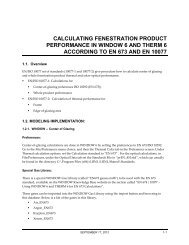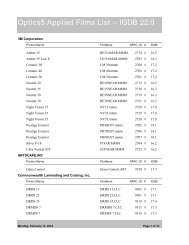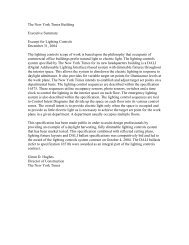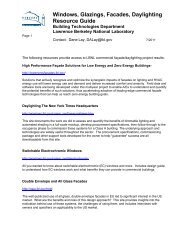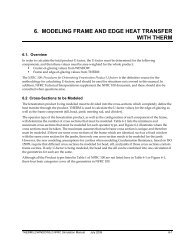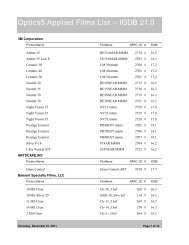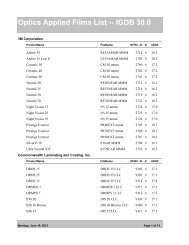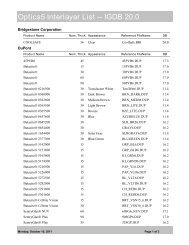Glazings for the 21st Century - Windows and Daylighting Group
Glazings for the 21st Century - Windows and Daylighting Group
Glazings for the 21st Century - Windows and Daylighting Group
Create successful ePaper yourself
Turn your PDF publications into a flip-book with our unique Google optimized e-Paper software.
4Contributing EditorsRoss McCluneyFlorida Solar Energy CenterVoice:(407) 638-1414Fax: (407) 638-1010e-mail: rmccluney@fsec.ucf.eduWeb:http://www.fsec.ucf.edu/~fen/Jeff ChristianOak Ridge National LaboratoryVoice: (423) 574-5207Fax: (423) 574-9338e-mail: jef@ornl.govWeb:http://www.ornl.gov/ORNL/Energy_Eff/btc.htmlAl Cz<strong>and</strong>ernaNational Renewable EnergyLaboratoryVoice: (303) 384-6460Fax: (303) 384-6604e-mail: al_cz<strong>and</strong>erna@nrel.govWeb: http://www.nrel.gov/Dragan CurcijaUniversity of MassachusettsVoice: (413) 545-2251Fax: (413) 545-1027e-mail: curcija@ecs.umass.eduWeb:http://www.ecs.umass.edu/mie/labs/berlJohn CarmodyMinnesota Building ResearchCenter1425 University Avenue SEMinneapolis MN 55455Voice: (612) 624-1351Fax: (612) 626-7424e-mail: carmo001@tc.unm.eduWeb:http://www.umn.edu/mnbrc/F A L LW I N T E R1 9 9 7LAWRENCE BERKELEYNATIONALLABORATORYENVIRONMENTALENERGYTECHNOLOGIES DIVISIONBUILDING TECHNOLOGIESPROGRAMWINDOWS & DAYLIGHTINGGROUPIntegrating Energy-Efficient FeaturesInto a Window/Wall Panel SystemTo integrate or to segregate?Residential windows combine acomplex set of material properties,mechanical mechanisms,<strong>and</strong> functional requirements.<strong>Windows</strong> must last many yearswhile keeping <strong>the</strong> elements out,<strong>the</strong> occupants com<strong>for</strong>table, allowingdaylight in, <strong>and</strong> providingview out. All this in a packagethat can be easily <strong>and</strong> reliablyinstalled in a building envelope.Integrated Window SystemOngoing research in manysectors of <strong>the</strong> building industryhave created improvements inall areas of window design <strong>and</strong>function. To achieve <strong>the</strong> nextstep, researchers at BerkeleyLab are integrating several keyenergy-efficient features into awindow/wall panel, an IntegratedWindow System (IWS).The key elements of an IntegratedWindow include an exteriorsun shade to block <strong>the</strong> sun'sheat, <strong>and</strong> an interior insulationthat covers <strong>the</strong> window at nightto keep <strong>the</strong> warmth inside. Amanufactured construction approachincludes <strong>the</strong>se energy-efficientfeatures in a full heightwall panel providing <strong>the</strong> wallstructure, <strong>the</strong> structural headerto transfer roof loads around <strong>the</strong>window, <strong>and</strong> a raceway <strong>for</strong> utilitiesrun under <strong>the</strong> window.Each of <strong>the</strong>se elements addsmeasurable gains in com<strong>for</strong>t <strong>and</strong><strong>the</strong>rmal control to <strong>the</strong> building’soccupants that are more reliable<strong>and</strong> more useful than devices installedin <strong>the</strong> field. By placing<strong>the</strong>se elements in a manufacturedunit <strong>the</strong>y can be employedto <strong>the</strong>ir optimum.ContactPaul LaBerge(510) 486-6830 Fax (510) 486-6099e-mail: P_LaBerge@lbl.govStriking Changesin Russian WindowProductionUntil recently, windows in Russianresidential buildings werelimited to three types: singleglazed, double-glazed, <strong>and</strong>triple-glazed. Insulated glassunits were used on rare occasion,but only in municipalbuildings <strong>and</strong> in public transportation.This was of little concernwhen heat prices were low.In fact, <strong>the</strong> cost of energy wassuch that an investment to replacedouble-glazed with tripleglazedwindows would havehad a payback period of at least20 years.Striking changes have occurredin <strong>the</strong> field of windowproduction in Russia within <strong>the</strong>past two years. Russia's transitionto a market economy, <strong>and</strong><strong>the</strong> sharp rises in prices of fuel<strong>and</strong> energy have stimulated interestin energy-efficient windows.Based on a review ofRussian legislation on <strong>for</strong>eigninvestment, <strong>the</strong> most favorablecourse of action <strong>for</strong> <strong>for</strong>eign investorsin <strong>the</strong> construction sectoris probably <strong>the</strong> establishmentof joint ventures withRussian partners. The followingdevelopments are indicative of<strong>the</strong> changing market environment:• Adoped new Federal constructionst<strong>and</strong>ards.• Established new voluntary certificationprogram by Ministryof Construction.• Increased Russian companies’manufacturing of new windowsby licensing <strong>for</strong>eign technology.• Russian companies producingglass <strong>and</strong> film with lowemissivitycoating with purchasesof <strong>for</strong>eign equipment.• In-country production capacity<strong>for</strong> ordinary 3-6-millimeterglass is approximately 135-140million square meters per year,enough to meet current dem<strong>and</strong>.• More than two billion squaremeters of buildings constructedsince 1961 need windowsreplaced to meet currentbuildings st<strong>and</strong>ards.• Market potential <strong>for</strong> IGUs estimatedat 24 million square feetper year. Currently, only 10 percentof this need is being met.• New construction in Moscowarea includes office buildings,business centers, <strong>and</strong> hotels, inpreparation <strong>for</strong> Moscow's 850thanniversary.ContactAlex SpiridonovSOLResearch Company,Moscow, Russia7 095 401-1960 Fax 7 095 482-4460e-mail: spiridon@santeh.msk.suFor more in<strong>for</strong>mation, seehttp://www.pnl.gov/aisu/spiridon.htm .Moscow WorkshopPlanned <strong>for</strong> May 1998Avery successful joint meetingwas held in Moscow in May1997 between a U.S. team,comprised of DOE researchers<strong>and</strong> manufacturers, <strong>and</strong> a Russianteam, comprising code officials<strong>and</strong> manufacturers. Afollow-upworkshop is planned <strong>for</strong>May 1998 in Moscow.ContactJohn Hogan(206) 386-9145 Fax (206) 233-7883e-mail: john.hogan@ci.seattle.wa.usWilliam Dupont(202) 484-0887 Fax (202) 484-0888e-mail: Waupi@msn.com
U.S. Department of EnergyThe Electrochromics InitiativeIn 1995, <strong>the</strong> U.S. Department of Energy (DOE)launched an Electrochromics Initiative to accelerateresearch <strong>and</strong> development on electrochromicmaterials that would lead ultimately to commercialproducts. After issuing a competitive solicitation<strong>for</strong> Phase One of <strong>the</strong> Initiative, <strong>the</strong> Departmentchose two manufacturers to develop electrochromicwindow prototypes, Optical CoatingLaboratory, Inc. (OCLI) of Santa Rosa, Cali<strong>for</strong>nia,<strong>and</strong> <strong>the</strong> Donnelly Corporation of Tucson, Arizona.Berkeley Lab's role in this work is to providetechnical oversight of <strong>the</strong> Initiative <strong>for</strong> DOE, tosupply technical assistance to <strong>the</strong>se companies, towork on improved materials <strong>for</strong> <strong>the</strong> coatings, <strong>and</strong>to assess <strong>the</strong> per<strong>for</strong>mance of electrochromic coatingsin buildings using simulation tools, fieldtests, <strong>and</strong> demonstration projects. Both vendorshave now delivered prototype windows of aboutone square foot in size. Berkeley Lab has conductedoptical characterization tests <strong>and</strong> Berkeley Labresearchers have also per<strong>for</strong>med computer simulationsof <strong>the</strong> prototypes' energy <strong>and</strong> visual per<strong>for</strong>manceusing, respectively, <strong>the</strong> DOE-2 <strong>and</strong> RADI-ANCE models. Al Cz<strong>and</strong>erna's group at <strong>the</strong> NationalRenewable Energy Laboratory (NREL) hasbeen conducting durability tests on <strong>the</strong> samples(see article below). The results of <strong>the</strong> durabilitytests have proven useful in helping <strong>the</strong> Initiative'sindustrial partners improve <strong>the</strong>ir processes <strong>and</strong> definewhere <strong>the</strong> work will proceed in <strong>the</strong> Initiative'ssecond phase.ContactMike Rubin(510) 486-7124 Fax (510) 486-6099e-mail: MDRubin@lbl.govNational Renewable Energy LaboratoryDeveloping Testing Protocol<strong>for</strong> Electrochromic <strong>Windows</strong>The National Renewable Energy Laboratory isleading <strong>the</strong> ef<strong>for</strong>t to develop a testing protocol <strong>for</strong>electrochromic windows (ECWs). This protocolwill be ideal <strong>for</strong> testing electrochromic samples,such as <strong>the</strong> one-foot-square specimens now underdevelopment at Optical Coating Laboratory, Inc.(OCLI) <strong>and</strong> Donnelly Corporation. Visual inspection<strong>and</strong> initial characterization <strong>for</strong> optical responseproperties are <strong>the</strong> first two steps of <strong>the</strong> protocol,followed by two tests, per<strong>for</strong>med in parallel.For a <strong>the</strong>rmal qualification test, <strong>the</strong> sampleswill be cycled between 76°C <strong>and</strong> -26°C at a cyclerate of five cycles per day (4.8 hours/cycle). Thesamples will not be exposed to solar radiation orhumidity, <strong>and</strong> <strong>the</strong>y will not be switched during <strong>the</strong>test, whose purpose is to establish that ECWs willsurvive <strong>the</strong> <strong>the</strong>rmal cycling anticipated when <strong>the</strong>yare in service.In <strong>the</strong> temperature-radiation-cyclic I-V (currentvoltage) test, alkali halide lamps in an AtlasXR260 four-by-six-foot accelerated testing chamberwill irradiate <strong>the</strong> sample. These lamps are filteredto provide an AM 1.5 solar spectrum, includingUV radiation from 290 to 400 nm. The ECWslie in a horizontal plane, <strong>and</strong> a detector measuresirradiation intensity in this plane. The chamber'sair temperature is constant <strong>and</strong> is chosen to providea mean ECW coating temperature of 60°Cduring <strong>the</strong> test. Each device will receive <strong>the</strong> I-V itrequires <strong>for</strong> coloring <strong>and</strong> bleaching, generally in<strong>the</strong> range of one to ten minutes per cycle. Irradiationby <strong>the</strong> alkali halide lamps increases <strong>the</strong> temperatureof <strong>the</strong> ECWs, especially in <strong>the</strong> coloredstate. Relative humidity in <strong>the</strong> chamber will bemeasured, but not controlled.ContactAl Cz<strong>and</strong>erna(303) 384-6460 Fax (303) 384-6604e-mail: al_cz<strong>and</strong>erna@nrel.govFlorida Solar Energy CenterComputationalAnalysis of ComplexFenestration SystemsRoss McCluney of <strong>the</strong> Florida Solar Energy Center,Coco, Florida, is leading <strong>the</strong> computationalpart of <strong>the</strong> ef<strong>for</strong>t to analyze complex fenestrationsystems.ASAPis a design <strong>and</strong> analysis computer program<strong>for</strong> large optical systems that evaluates notonly specularly reflecting <strong>and</strong> transmitting elements,but diffuse surfaces as well. An ASAPusercan enter complex shading <strong>and</strong> o<strong>the</strong>r fenestrationsystem geometries, <strong>and</strong> specify a distribution,both geometric <strong>and</strong> spectral, of electromagneticradiation incident on <strong>the</strong> system. The programgenerates output data that characterizes <strong>the</strong> wholefenestration system as an object, <strong>and</strong> predicts <strong>the</strong>complete angular <strong>and</strong> spectral distributions of itsoptical properties.Since ASAPis an optical programming language,as well as a powerful computational tool, itshould be possible to prepare a custom versionadapted to <strong>the</strong> specific problem of calculating <strong>the</strong>optical properties of complex fenestration systems.ContactRoss McCluneyFlorida Solar Energy Center(407) 783-0300 Fax (407) 783-2571e-mail: rmccluney@fsec.ucf.edu5MoWiTTTests ofElectrochromic PrototypesSmall-scale electrochromicprototypes from Donnelly<strong>and</strong> OCLI, participants in<strong>the</strong> DOE/ElectrochromicInitiative, have recentlybeen tested in <strong>the</strong> MoWiTTfield test facility. The glazingswere incorporated intoskylight frames supplied byVelux. The summer testprogram included commerciallyavailable clear, tinted,<strong>and</strong> spectrally selectiveglazings as well. This projectrepresents <strong>the</strong> first useof MoWiTT<strong>for</strong> skylighttesting <strong>and</strong> will providevaluable field experience<strong>and</strong> per<strong>for</strong>mance data on energyflows <strong>and</strong> temperaturesexperienced by <strong>the</strong> skylights<strong>and</strong> <strong>the</strong>ir glazing assemblies.ContactJoseph Klems(510) 486-5564Fax (510) 486-4089e-mail: JHKlems@lbl.govF A L LW I N T E R1 9 9 7LAWRENCE BERKELEYNATIONALLABORATORYENVIRONMENTALENERGYTECHNOLOGIES DIVISIONBUILDING TECHNOLOGIESPROGRAMWINDOWS & DAYLIGHTINGGROUP
6Fenestration Facts“The most promising smartwindow technology may bedevices based onelectrochromic coatings.Although not yet commerciallyavailable, <strong>the</strong>y appearto have a good chance tomeet per<strong>for</strong>mance, cost, <strong>and</strong>manufacturing requirementsthat would result in a marketablewindow system.”F A L LW I N T E R1 9 9 7Residential <strong>Windows</strong>John Carmody et al1996LAWRENCE BERKELEYNATIONALLABORATORYENVIRONMENTALENERGYTECHNOLOGIES DIVISIONBUILDING TECHNOLOGIESPROGRAMWINDOWS & DAYLIGHTINGGROUPGlazing exists because of its optical clarity<strong>and</strong> light transmission properties. Increasinglyimportant is <strong>the</strong> ability of coatedglazing to control infrared <strong>and</strong> ultraviolet radiation.Dynamic coatings such as electrochromics,anisotropic <strong>and</strong> light-redirecting materials, geometricallycomplex insulation <strong>and</strong> shading systemswill control optical radiation in new ways.Optical <strong>and</strong> radiative properties of glazing materials<strong>the</strong>re<strong>for</strong>e are primaryinputs <strong>for</strong> determining<strong>the</strong> energy per<strong>for</strong>manceof buildings. Accordingly,LBNLmaintains oneof <strong>the</strong> most extensive facilitiesin <strong>the</strong> world <strong>for</strong>characterizing <strong>the</strong> opticalproperties of glazingmaterials, includingseven specialized instruments<strong>and</strong> <strong>the</strong> analyticaltools needed to interpret<strong>the</strong> results <strong>and</strong> extractuseful in<strong>for</strong>mation.The Glazing OpticsCharacterization LaboratorySpecialized Equipment Helps Accurately Determine <strong>the</strong> Energy <strong>and</strong> VisualPer<strong>for</strong>mance of Existing Products <strong>and</strong> Experimental Glazing MaterialsThe optical properties of simple glazing typessuch as coated <strong>and</strong> uncoated glass <strong>and</strong> plastic areconventionally tested at normal incidence (lightstrikes <strong>the</strong> glass at 90° to <strong>the</strong> surface). The NationalFenestration Rating Council (NFRC), with <strong>the</strong>technical assistance of LBNL, established proceduresthat provide <strong>for</strong> accurate measurement <strong>and</strong>calculation of several different optical properties.These properties are <strong>the</strong>n used in a nationwideprogram to rate <strong>and</strong> label <strong>the</strong> energy per<strong>for</strong>manceof windows. As a result, all major U.S. glazingmanufacturers now follow a uni<strong>for</strong>m characterizationprocedure. LBNL has collected <strong>and</strong> validatedspectral data <strong>for</strong> over 750 glazing products, <strong>and</strong>distributes <strong>the</strong> data on a diskette or by downloadfrom our web site. The 5th release occurred inSeptember <strong>and</strong> is <strong>the</strong> first to include internationaldata, although it is not yet NFRC certified.The integrity of <strong>the</strong> glazing database is guaranteedboth by peer comparison <strong>and</strong> by checks ofeach file at LBNL. Atypical operation involves<strong>the</strong> measurement of product parameters needed<strong>for</strong> calculations of SHGF, U-factor, <strong>and</strong> even annualenergy per<strong>for</strong>mance. St<strong>and</strong>ard measurementsFigure 1. Ellipsometer determination of opticalindices.of spectral transmittance <strong>and</strong> reflectance at normalincidence are made with highly automatedspectrometers. APerkin-Elmer Lambda 19 withLabsphere RSA-19 integrating sphere is used <strong>for</strong>solar range measurements on glazing products.Emittance is measured with a Nicolet FTIR with aCsI beamsplitter <strong>for</strong> extended range in <strong>the</strong> <strong>the</strong>rmalinfrared. Under <strong>the</strong> auspices of <strong>the</strong> NFRC, glazingmanufacturers can measure <strong>the</strong>ir own materialsusing similar spectrometers.Significant error inthis type of measurement,however, is common,as shown by roundrobin studies among <strong>the</strong>NFRC manufacturers toge<strong>the</strong>rwith <strong>the</strong> IEATask 18. If any featureof a spectrum appears tobe incorrect, more versatile<strong>and</strong> accurateequipment is employedas described below.With <strong>the</strong> basic ratingsystem working smoothly, <strong>the</strong> issue of propertiesneeded to calculate annual energy per<strong>for</strong>mancebecomes primary. Sunlight often strikes glass atoblique angles <strong>for</strong> which <strong>the</strong> transmittance <strong>and</strong> reflectanceare significantly different from <strong>the</strong>ir valuesat normal incidence. Areliable procedure <strong>for</strong>extrapolating from normal properties to obliqueproperties is thus needed <strong>for</strong> accurate annual energyper<strong>for</strong>mance calculations. Several instrumentsare available to measure angle-dependent propertieswith high accuracy. Asingle-beam goniophotometeremploying a feedback-stabilized laserdiode with a short coherence length in conjunctionwith a large-area silicon detector provides absoluteverification at 670 nm <strong>and</strong> any angle of incidence.We also have a goniospectroradiometer describedin more detail below in connection withcomplex glazing. In principle, this instrument canmeasure all required angle-dependent properties,but accuracy is still an open issue. No st<strong>and</strong>ardprocedures or reference materials yet exist. Finally,we have a variable-angle spectroscopic ellipsometer(Fig. 1) which is used to determine fundamentaloptical constants of <strong>the</strong> glazings. These capabilities,however, do not exist in most industrial
8<strong>21st</strong> <strong>Century</strong> <strong>Glazings</strong> ...(continued from page 1)Fenestration Facts“Avariant of <strong>the</strong> liquidcrystal display technologyused in wristwatches is nowserving as a privacy glazing<strong>for</strong> new windows. Averythin layer of liquid crystalsis s<strong>and</strong>wiched between twotransparent electricalconductors on thin plasticfilms <strong>and</strong> <strong>the</strong> entire packageis laminated between twolayers of glass. When <strong>the</strong>power is off, <strong>the</strong> liquidcrystals are in a r<strong>and</strong>om <strong>and</strong>unaligned state. Whenpower is applied, <strong>the</strong> electricfield in <strong>the</strong> devicealigns <strong>the</strong> liquid crystals<strong>and</strong> <strong>the</strong> glazing becomesclear in a fraction of a second,permitting view inboth directions.”F A L LW I N T E R1 9 9 7Residential <strong>Windows</strong>John Carmody et al1996LAWRENCE BERKELEYNATIONALLABORATORYENVIRONMENTALENERGYTECHNOLOGIES DIVISIONBUILDING TECHNOLOGIESPROGRAMWINDOWS & DAYLIGHTINGGROUPtime failure as well as to diagnose<strong>and</strong> correct device problems(see page 5).Thin Film DepositionProcessesProcess modification <strong>for</strong> developmentof improved low-emittance<strong>and</strong> solar control coatingscan be achieved through <strong>the</strong> useof advanced plasma technologydeveloped at LBNL. Anewtype of constricted glow-dischargeplasma source was recentlyselected <strong>for</strong> <strong>the</strong> prestigiousR&D 100 Award. Inventedby LBNL researchers AndreAnders, Mike Rubin, <strong>and</strong> MikeDickenson, <strong>the</strong> source was designedto be compatible with industrialvacuum depositionequipment <strong>and</strong> practice. Constructionis simple, rugged, <strong>and</strong>inexpensive. The source can operateindefinitely over a widerange of chamber pressure withoutany consumable parts suchas filaments or grids. Among <strong>the</strong>uses of <strong>the</strong> source are densificationof coatings <strong>for</strong> greater durability,crystallization at low temperatures<strong>for</strong> increased reflectivityor electrical conductivity, enhancementof reactivity to producean o<strong>the</strong>rwise unstablephase or increase depositionrate, <strong>and</strong> control over composition.Several of <strong>the</strong>se sourceshave been fabricated <strong>for</strong> specificuses by glazing manufacturers.LBNL will assist <strong>the</strong>se manufacturersto optimize <strong>the</strong> sourcecharacteristics <strong>and</strong> to developnew coating types. Recently, alinear configuration was successfullytested. Consisting ofan array of miniaturized versionsof <strong>the</strong> original source, thislinear source is extendible to adeposition system of any width.International Collaborationon Optical MaterialsLBNLstaff continue to participateactively in several international<strong>for</strong>ums under <strong>the</strong> auspicesof <strong>the</strong> International EnergySimulation tools, such as <strong>the</strong>se RADIANCE ray tracing images, comparevisibility of a computer screen with conventional clear glass (lower left),tinted glass (lower right), <strong>and</strong> electrochromic glass (top left), using two differentcontrol strategies.Agency (IEA). LBNL led <strong>the</strong>subtask on Chromogenics underIEATask 18 which concluded inMarch. Switchable glazing technologiessuch as liquid crystals<strong>and</strong> <strong>the</strong>rmochromics, as well aselectrochromics, were investigated<strong>and</strong> compared. Asurveywas made of <strong>the</strong> companies involvedworldwide <strong>and</strong> <strong>the</strong> statusof <strong>the</strong>ir technology. Test methods<strong>and</strong> results were compared<strong>for</strong> a variety of small sampletypes <strong>and</strong> some large electrochromics.Energy per<strong>for</strong>manceof <strong>the</strong>se technologieswas evaluated in ano<strong>the</strong>r subtaskled by Bob Sullivan ofLBNL. Reports were producedon various specific technologies<strong>and</strong> a final report will be availablelater this year. One newstudy used DOE-2 to evaluate<strong>the</strong> per<strong>for</strong>mance of angle-selectiveprototypes developed byProf. Geoff Smith of <strong>the</strong> Universityof Technology at Sydney.(See <strong>the</strong> regular update onIEATask 18 on page 2).Materials CharacterizationStudiesCharacterization of <strong>the</strong>se newglazing materials is an importantpart of our research. Structural<strong>and</strong> compositional analysisis per<strong>for</strong>med using a variety offacilites available at LBNL.These techniques range fromst<strong>and</strong>ard techniques such as x-ray diffraction, or less commontechniques such as Nuclear ReactionAnalysis <strong>for</strong> detection oflithium in electrochromics, toexotic <strong>and</strong> unique applicationsof atomic resolution electronmicroscopy or <strong>the</strong> syncrotron atLBNL's Advanced LightSource. Amore complete listing<strong>and</strong> description of <strong>the</strong>se generalmaterials science capabilitiesmay be found on LBNL's website, http://www.lbl.gov. Optical<strong>and</strong> <strong>the</strong>rmal characterization ofwindows are of particular importanceto our energy efficiencyprogram, so we maintainspecialized facilites in <strong>the</strong>seareas. Thermal facilites werehighlighted in previous issues.The Optical CharacterizationFacility <strong>for</strong> glazing is describedin detail in a separate article onpage 6.ContactMike Rubin(510) 486-7124 Fax (510) 486-6099e-mail: MDRubin@lbl.gov
Exciting New Publications<strong>for</strong> <strong>the</strong> Building Industry9Fenestration FactsResidential <strong>Windows</strong>,A Guide to NewTechnologies <strong>and</strong> EnergyPer<strong>for</strong>manceJohn Carmody, StephenSelkowitz, Lisa HeschongAvailable from W. W. Norton &Company, paperback, 214 pp,1996, $22.00. Website orders:http://www.wwnorton.com/catalog/spring96/073004.htmAcomprehensive overviewof design principles, applicationsguide <strong>for</strong> windows <strong>and</strong>skylights, description of latesttechnology innovations <strong>and</strong><strong>the</strong>ir energy impacts, <strong>and</strong> resourcematerials.ContactPat RossBuilding Technologies Program,Lawrence BerkeleyNational Laboratory,MS: 90-3111, Berkeley CA94720Fax (510) 486-4089e-mail: PLRoss@lbl.govTips <strong>for</strong> <strong>Daylighting</strong>with <strong>Windows</strong>:The Integrated ApproachJennifer O'Connor, Eleanor Lee,Francis Rubinstein, StephenSelkowitz, BuildingTechnologies Program,Lawrence Berkeley NationalLaboratory, 1997.Apractical "how-to" guide<strong>for</strong> applying daylighting strategiesin commercial buildings,with a systems integration perspective.Chapters include DaylightFeasibility, Envelope <strong>and</strong>Room Decisions, Glazing Selections,Shading Strategy, MechanicalCoordination, LightingCoordination, Sensors <strong>and</strong> Controls,Calibration <strong>and</strong> Commissioning,Maintenance, <strong>and</strong> Cost-Benefit Analysis.Review <strong>the</strong> table of contents<strong>and</strong> sample chapter under Publicationsat Building TechnologiesProgram’s web site:http://e<strong>and</strong>e.lbl.gov/btp. Singlecopies of <strong>the</strong> document can bedownloaded in PDF <strong>for</strong>matfrom <strong>the</strong> web site. If you are interestedin reprinting <strong>the</strong> document,please contact us.ContactSteve SelkowitzFax (510) 486-4089e-mail: SESelkowitz@lbl.govSelecting <strong>Windows</strong> <strong>for</strong>Energy EfficiencyThis 16-page brochure discusses<strong>the</strong> new residential windowtechnologies that have increasedenergy benefits <strong>and</strong> com<strong>for</strong>t,providing more practical options<strong>for</strong> consumers. Written as aguide <strong>for</strong> homeowners, architects,<strong>and</strong> builders, <strong>the</strong> brochureprovides guidance on <strong>the</strong> NationalFenestration RatingCouncil’s window energy rating<strong>and</strong> labeling, design recommendations,<strong>and</strong> a valuable windowchecklist <strong>for</strong> design, specification,<strong>and</strong> installation.Review <strong>the</strong> table of contents<strong>and</strong> download <strong>the</strong> document inPDF <strong>for</strong>mat from <strong>the</strong> BuildingTechnologies Program web site:http://e<strong>and</strong>e.lbl.gov/btp.Copies are available fromEREC/Energy Efficiency <strong>and</strong>Renewable Energy Clearinghouse,P.O. Box 3048, Merrifield,VA22116 or call (800)363-3732, fax (703) 893-0440.If you are interested in reprinting<strong>the</strong> brochure to include yourorganization’s identification,please contact us directly.ContactPat RossFax (510) 486-4089e-mail: PLRoss@lbl.gov“Adopt a holistic design approach,where <strong>the</strong> buildingis viewed as a whole <strong>and</strong>not just a collection of parts.Common practice oftenfails to address <strong>the</strong> criticalinteractions between <strong>the</strong>building facade (which admitsheat <strong>and</strong> light) <strong>and</strong> <strong>the</strong>electric lighting system, resultingin an uncom<strong>for</strong>table<strong>and</strong> ineffecient building thatis expensive <strong>and</strong> difficult toretrofit.”Tips <strong>for</strong> <strong>Daylighting</strong>with <strong>Windows</strong>,The Integrated ApproachJennifer O’Connor et al1997F A L LW I N T E R1 9 9 7LAWRENCE BERKELEYNATIONALLABORATORYENVIRONMENTALENERGYTECHNOLOGIES DIVISIONBUILDING TECHNOLOGIESPROGRAMWINDOWS & DAYLIGHTINGGROUP
F A L LW I N T E R1 9 9 710Fenestration Facts“When shopping <strong>for</strong>windows <strong>and</strong> skylights, payclose attention to whe<strong>the</strong>r<strong>the</strong> U-factor listed by <strong>the</strong>manufacturer applies to <strong>the</strong>glazing only or to <strong>the</strong> entireunit. If it is <strong>for</strong> <strong>the</strong> glazingonly, <strong>the</strong> overall U-factormay be considerably higherbecause of <strong>the</strong> frame <strong>and</strong>spacer effects. These effectsincrease with decreasingtotal window area.”Selecting <strong>Windows</strong> <strong>for</strong>Energy EfficientyU.S. Department of Energy1997LAWRENCE BERKELEYNATIONALLABORATORYENVIRONMENTALENERGYTECHNOLOGIES DIVISIONBUILDING TECHNOLOGIESPROGRAMWINDOWS & DAYLIGHTINGGROUPRecent ResearchPublicationsElectrochromic Lithium NickelOxide by Pulsed LaserDeposition<strong>and</strong> Sputtering. 1996. Rubin M.,Wen S-H., Richardson T., Kerr J.,von Rottkay K., Slack J. SPIE InternationalSymposium on OpticalMaterials Technology <strong>for</strong> EnergyEfficiency <strong>and</strong> Solar Energy ConversionXV, Freiburg, Germany. Tobe published in Solar Energy Materials<strong>and</strong> Solar Cells.Abstract: Thin films of lithiumnickel oxide were deposited bysputtering <strong>and</strong> pulsed laser deposition(PLD) from targets of pressedLiNiO 2 powder. The composition<strong>and</strong> structure of <strong>the</strong>se films wereanalyzed using a variety of techniques,such as nuclear-reactionanalysis, Ru<strong>the</strong>r<strong>for</strong>d backscatteringspectrometry (RBS), x-ray diffraction,infrared spectroscopy, <strong>and</strong>atomic <strong>for</strong>ce microscopy. Crystallinestructure, surface morphology<strong>and</strong> chemical composition ofLi x Ni 1-x O thin films depend stronglyon deposition oxygen pressure,temperature, as well as substratetargetdistance. The films producedat temperatures lower than 600°Cspontaneously absorb CO 2 <strong>and</strong> H 2 Oat <strong>the</strong>ir surface once <strong>the</strong>y are exposedto <strong>the</strong> air. The films depositedat 600°C proved to be stable inair over a long period. Even at roomtemperature <strong>the</strong> PLD films aredenser <strong>and</strong> more stable than sputteredfilms. RBS determined <strong>the</strong>composition of <strong>the</strong> best films to beLi 0.5 Ni 0.5 O deposited by PLD at 60mTorr O 2 pressure. Electrochemicaltests show that <strong>the</strong> films exhibit excellentreversibility in <strong>the</strong> range 1.0Vto 3.4 Vversus lithium. Electrochemical<strong>for</strong>matting which is usedto develop electrochromism in o<strong>the</strong>rfilms is not needed <strong>for</strong> <strong>the</strong> stoichiometricfilms. The optical transmissionrange is almost 70% at 550 nm<strong>for</strong> 150-nm thick films. Devicesmade from <strong>the</strong>se films were analyzedusing novel reference electrodes<strong>and</strong> by disassembly after cycling.Energy Per<strong>for</strong>mance of Evacuated<strong>Glazings</strong> in Residential Buildings.1995. Sullivan R., Beck F.,Arasteh D., Selkowitz S. ASHRAETransactions 102(2) (1996). (LBL-37130 Rev.)Abstract: This paper presents <strong>the</strong>results of a study investigating <strong>the</strong>energy per<strong>for</strong>mance of evacuatedglazings or glazings which maintaina vacuum between two panes ofglass. Their per<strong>for</strong>mance is measuredby comparing results to prototypehighly insulated superwindowsas well as a more conventional insulatingglass unit with a low-Ecoating <strong>and</strong> argon gas fill. We used<strong>the</strong> DOE-2.1E energy analysis simulationprogram to analyze <strong>the</strong> annual<strong>and</strong> hourly heating energy usedue to <strong>the</strong> windows of a prototypicalsingle-story house located inMadison, Wisconsin. Cooling energyper<strong>for</strong>mance was also investigated.Our results show that <strong>for</strong> highlyinsulating windows, <strong>the</strong> solar heatgain coefficient is as important as<strong>the</strong> window's U-factor in determiningheating per<strong>for</strong>mance <strong>for</strong> windoworientations facing west-sou<strong>the</strong>ast.For o<strong>the</strong>r orientations inwhich <strong>the</strong>re is not much direct solarradiation, <strong>the</strong> window's U-factorprimarily governs per<strong>for</strong>mance.The vacuum glazings had lowerheating requirements than <strong>the</strong> superwindows<strong>for</strong> most window orientations.The conventional low-Ewindow outper<strong>for</strong>med <strong>the</strong> superwindows<strong>for</strong> southwest-southsou<strong>the</strong>astorientations. These per<strong>for</strong>mancedifferences are directlyrelated to <strong>the</strong> solar heat gain coefficientsof <strong>the</strong> various windows analyzed.The cooling per<strong>for</strong>mance of<strong>the</strong> windows was inversely relatedto <strong>the</strong> heating per<strong>for</strong>mance. Thelow solar heat gain coefficients of<strong>the</strong> superwindows resulted in <strong>the</strong>best cooling per<strong>for</strong>mance. However,we were able to mitigate <strong>the</strong>cooling differences of <strong>the</strong> windowsby using an interior shading devicethat reduced <strong>the</strong> amount of solargain.Advanced Optical <strong>Daylighting</strong>Systems: Light Shelves <strong>and</strong> LightPipes. 1995. Beltrán L.O., LeeE.S., <strong>and</strong> Selkowitz S.E. 1996.IESNAAnnual Conference, August4-7, 1996, Clevel<strong>and</strong>, OH, <strong>and</strong> to beconsidered <strong>for</strong> publication in <strong>the</strong>Journal of <strong>the</strong> IES <strong>and</strong> Lighting Design<strong>and</strong> Application. (LBL-38133)Abstract: We present two perimeterdaylighting systems that passivelyredirect beam sunlight fur<strong>the</strong>rfrom <strong>the</strong> window wall usingspecial optical films, an optimizedgeometry, <strong>and</strong> a small glazing aperture.The objectives of <strong>the</strong>se systemsare (1) to increase daylight illuminancelevels at 4.6-9.1 m (15-30 ft) from <strong>the</strong> window aperturewith minimum solar heat gains <strong>and</strong>(2) to improve <strong>the</strong> uni<strong>for</strong>mity of <strong>the</strong>daylighting luminance gradientacross <strong>the</strong> room under variablesolar conditions throughout <strong>the</strong>year. The designs were developedthrough a series of computer-assistedray-tracing studies, laser visualizationtechniques, <strong>and</strong> photometricmeasurements <strong>and</strong> observationsusing physical scale models. Bidirectionalilluminance measurementsin combination with analytical routineswere <strong>the</strong>n used to simulatedaylight per<strong>for</strong>mance <strong>for</strong> any solarposition, <strong>and</strong> were incorporated into<strong>the</strong> DOE-2.1E building energy analysiscomputer program to evaluateenergy savings. Results show increaseddaylight levels <strong>and</strong> an improvedluminance gradient throughout<strong>the</strong> year compared to conventionaldaylighting systems.Surface Temperatures of InsulatedGlazing Units: Infrared ThermographyLaboratory Measurements.1995. Griffith B.T., TürlerD., <strong>and</strong> Arasteh D. 1996 ASHRAETransactions 102(2), San Antonio,TX. (LBL-38117)Abstract: Data are presented <strong>for</strong><strong>the</strong> distribution of surface temperatureson <strong>the</strong> warm-side surface ofseven different insulated glazingunits. Surface temperatures aremeasured using infrared <strong>the</strong>rmography<strong>and</strong> an external referencingtechnique. This technique allowsdetailed mapping of surface temperaturesthat is non-intrusive. Theglazings were placed between warm<strong>and</strong> cold environmental chambersthat were operated at conditionscorresponding to st<strong>and</strong>ard designconditions <strong>for</strong> winter heating. Thetemperature conditions are 21.1°C(70°F) <strong>and</strong> -17.8°C (0°F) on <strong>the</strong>warm <strong>and</strong> cold sides, respectively.Film coefficients varied somewhatwith average conditions of about7.6 W/m 2. K (1.34 Btu/h . ft 2.° F) <strong>for</strong><strong>the</strong> warm-side <strong>and</strong> 28.9 W/m 2. K(5.1 Btu/h . ft 2.° F) <strong>for</strong> <strong>the</strong> cold-side.Surface temperature data are plotted<strong>for</strong> <strong>the</strong> vertical distribution along<strong>the</strong> centerline of <strong>the</strong> IG <strong>and</strong> <strong>for</strong> <strong>the</strong>horizontal distribution along <strong>the</strong>centerline. This paper is part of alarger collaborative ef<strong>for</strong>t that studied<strong>the</strong> same set of glazings.For copies contactPat Ross(510) 486-6845 Fax (510) 486-4089e-mail: PLRoss@lbl.govhttp://e<strong>and</strong>e.lbl.gov/btp
UserFacilitiesIndustry is invited to collaboratein <strong>the</strong> use of <strong>the</strong>se facilities. Ineach issue of FenestrationR&D we will take a closer lookat one of our user facilities.Please contact <strong>the</strong> individual researcherlisted under each facilityto discuss potential use.❐ Mobile Window Thermal TestFacility (MoWiTT) The MoWiTTfacility contains two highly instrumented,side-by-side calorimetrictest chambers that are used to testwindow <strong>and</strong> wall elements underactual outdoor conditions. The facilitymay be rotated to face in anydirection <strong>and</strong> is currently located inReno, Nevada, which experiencesboth summer <strong>and</strong> winter extremeclimate conditions. It can directlymeasure solar heat gain <strong>and</strong> can beused to determine window <strong>and</strong>shading system properties <strong>for</strong> awide variety of solar control options.With 200 data channels collectingdata every few seconds, <strong>the</strong>facility can directly measure coolingload shapes on peak summerdays with excellent time resolution.The facility can also be used to validatecomputer models <strong>and</strong> to comparevarious technologies in realtime. Industry has used MoWiTTresults to justify new product development.ContactJoseph Klems(510) 486-5564 Fax (510) 486-4089e-mail: JHKlems@LBL.gov❐ IR Camera Test Facility Thisfacility includes a high-resolution,infrared imaging camera, a computerprocessor/printer, <strong>and</strong> a cold/hotchamber to hold samples <strong>for</strong> testing.The camera system is portable<strong>and</strong> can measure surface temperaturesthat can <strong>the</strong>n be correlated tovarious heat loss or gain parameters.The IR camera is useful <strong>for</strong> assessingheat loss from existingbuildings in <strong>the</strong> field as well asfrom building components <strong>and</strong> appliancesin <strong>the</strong> laboratory setting.ContactBrent Griffith(510) 486-6061 Fax (510) 486-4089e-mail: BTGriffith@LBL.gov❐ Thin-Film Materials LaboratoryThis laboratory includes a widerange of apparatus to deposit <strong>and</strong>analyze thin-film coatings <strong>for</strong> energycontrol purposes. The laboratory’sthin-film deposition systemsare used to make new types of selective<strong>and</strong> electrochromic coatings.The laboratory also includes spectrophotometersto measure solar,near IR, <strong>and</strong> far IR properties.ContactMike Rubin(510) 486-7124 Fax (510) 486-6099e-mail: MDRubin@LBL.gov❐ Sky Simulator The 24-foot-diametersky simulator is a hemisphericalfacility used to test daylightingper<strong>for</strong>mance in scalemodelbuildings under controlled<strong>and</strong> reproducible conditions. Computerizedcontrol of light sourceswithin <strong>the</strong> hemisphere can createluminous distributions typical ofclear, uni<strong>for</strong>m, or overcast skiesrepresentative of any desired location,orientation, climate, <strong>and</strong> seasonon Earth. It can also be used asa sun simulator to test shadingstrategies in scale models up to 1.5square meters in size. Light levelswithin <strong>the</strong> models are measured by60 photosensors <strong>and</strong> <strong>the</strong> measurementsare used to predict daylightilluminance conditions within fullsizedbuildings.ContactStephen Selkowitz(510) 486-5064 Fax (510) 486-4089e-mail: SESelkowitz@LBL.gov❐ Solar Heat Gain Scanner Thisdevice is used to characterize <strong>the</strong>complex optical properties of glazings<strong>and</strong> shading systems that aregeometrically complex, such asvenetian blinds. The system measurestransmitted <strong>and</strong> reflected energy<strong>and</strong> light at all incidence <strong>and</strong>outgoing angles. The scanner hasbeen used to develop a new procedureto predict solar heat gainthrough complex shading systems.ContactJoseph Klems(510) 486-5564 Fax (510) 486-4089e-mail: JHKlems@LBL.govSoftwareAvailable❐ ADELINE 2.0 analyzes lightingenergy savings in buildings that utilizedaylighting. Its unique collectionof software tools <strong>for</strong> <strong>the</strong> MS-DOS plat<strong>for</strong>m includes Radiancev2.4, Superlite 2.0 IEA, Scribe (a3D editor <strong>for</strong> simple scenes), <strong>and</strong> a<strong>Windows</strong>-like graphical user interfacethat ties <strong>the</strong>se tools toge<strong>the</strong>r.The package comes with an extensive475 page manual in a looseleaf3-ring binder, context-sensitivehelp menus, online hyper-text help,<strong>and</strong> installs from CD-ROM.ContactCharles EhrlichFAX (510) 486-4089e-mail: CKEhrlich@lbl.govWeb: http://radsite.lbl.gov/adeline/HOME.html❐ RESFEN 3.0 is a WINDOWS95 (or NT)-based PC program <strong>for</strong>calculating residential fenestrationheating <strong>and</strong> cooling energy use <strong>and</strong>costs. This new program (whichuses <strong>the</strong> DOE-2 calculation engine)is currently being evaluated <strong>for</strong> possibleuse as part of a window ratingsystem being developed by <strong>the</strong> NationalFenestration Rating Council(NFRC).❐ SUPERLITE 2.0 is a PC programthat calculates daylight illuminancedistributions <strong>for</strong> complexroom <strong>and</strong> light source geometrieswith tested accuracy. SUPERLITEwill model daylight coming throughas many as five openings <strong>and</strong> beingreflected from as many as 20opaque surfaces oriented in any direction.❐ WINDOW 4.1 is a <strong>the</strong>rmalanalysis PC program that is <strong>the</strong> defacto st<strong>and</strong>ard used by U.S. manufacturersto characterize productper<strong>for</strong>mance. The program is usedby <strong>the</strong> National Fenestration RatingCouncil as <strong>the</strong> basis <strong>for</strong> developmentof energy rating labels <strong>for</strong>windows.❐ THERM 1.0 is a Microsoft<strong>Windows</strong>-based 2D heat transferanalysis tool, based on finite elementanalysis <strong>and</strong> can model twodimensionalheat transfer with aminimum of simplifications toexact cross-section geometries.ContactPat Ross(510) 486-6845 Fax (510) 486-4089e-mail: PLRoss@LBL.gov11The Fenestration R&Dnewsletter provides a periodicupdate on U.S. Departmentof Energy-sponsoredwindows <strong>and</strong> glazings researchat Lawrence BerkeleyNational Laboratory, aswell as o<strong>the</strong>r DOE-supportedactivities at Florida SolarEnergy Center, NationalRenewable Energy Laboratory,Oak Ridge NationalLaboratory, University ofMassachusetts, <strong>and</strong> TuftsUniversity.Fenestration R&D ismade possible with supportfrom <strong>the</strong> U.S. Departmentof Energy, Assistant Secretary<strong>for</strong> Energy Efficiency<strong>and</strong> Renewable Energy, Officeof Building Technology,State <strong>and</strong> CommunityPrograms, Office of BuildingSystems.Samuel J. TaylorProgramManager, Building Systems<strong>and</strong> Materials DivisionLBNL’s <strong>Windows</strong> <strong>and</strong><strong>Daylighting</strong> <strong>Group</strong> developsadvanced optical materials,studies fenestrationper<strong>for</strong>mance, <strong>and</strong> createscomputer-based tools <strong>and</strong>applications guides <strong>for</strong> improving<strong>the</strong> energy-relatedper<strong>for</strong>mance of windows.Stephen E. SelkowitzProgram Head, BuildingTechnologiesF A L LW I N T E R1 9 9 7LAWRENCE BERKELEYNATIONALLABORATORYENVIRONMENTALENERGYTECHNOLOGIES DIVISIONBUILDING TECHNOLOGIESPROGRAMWINDOWS & DAYLIGHTINGGROUP
12PUB-762 Fall/Winter 1997-5000This work was supported by <strong>the</strong> U.S. Departmentof Energy under Contract No.DE-AC03-76SF00098Environmental EnergyTechnologies DivisionLawrence Berkeley National LaboratoryUniversity of Cali<strong>for</strong>niaBerkeley, CA94720 USAAn Equal Opportunity EmployerThis document was prepared as an accountof work sponsored by <strong>the</strong> UnitedStates Government. While this documentis believed to contain correct in<strong>for</strong>mation,nei<strong>the</strong>r <strong>the</strong> United States Government norany agency <strong>the</strong>reof, nor The Regents of<strong>the</strong> University of Cali<strong>for</strong>nia, nor any of<strong>the</strong>ir employees, makes any warranty, expressor implied, or assumes any legal responsibility<strong>for</strong> <strong>the</strong> accuracy, completeness,or usefulness of any in<strong>for</strong>mation, apparatus,product, or process disclosed, orrepresents that its use would not infringeprivately owned rights. Reference hereinto any specific commercial product, process,or service by its trade name, trademark,manufacturer, or o<strong>the</strong>rwise, doesnot necessarily constitute or imply its endorsement,recommendation, or favoringby <strong>the</strong> United States Government or anyagency <strong>the</strong>reof, or The Regents of <strong>the</strong>University of Cali<strong>for</strong>nia. The views <strong>and</strong>opinions of authors expressed herein donot necessarily state or reflect those of <strong>the</strong>United States Government or any agency<strong>the</strong>reof, or The Regents of <strong>the</strong> UniversitySponsors of research describedin this issue include:Cali<strong>for</strong>nia Institute <strong>for</strong> Energy EfficiencyU.S. Department of EnergyFederal Energy Management ProgramOffice of Building TechnologiesFenestration R&D is made possiblewith support from <strong>the</strong> U.S. Departmentof Energy, Assistant Secretary<strong>for</strong> Energy Efficiency <strong>and</strong>Renewable Energy, Office of BuildingTechnology, State <strong>and</strong> CommunityPrograms, Office of BuildingSystems, Building Systems <strong>and</strong> MaterialsDivision, Samuel J. Taylor,program manager.NFRCUpdateNational Fenestration Rating CouncilNew Image <strong>for</strong> NFRCIt’s official! The NFRC membership overwhelminglyadopted a new logo at <strong>the</strong> Spring 1997Membership Meeting in Nashville, Tennessee.The new multi-faceted logo reflects <strong>the</strong> manydifferent aspects of NFRC’s mission. The newlogo emphasizes <strong>the</strong> importance of both heating<strong>and</strong> cooling per<strong>for</strong>mance of fenestration. Thequadrant design gives <strong>the</strong> appearance of a window,while symbolizing different climate regions.The new logo will begin to appear immediatelyon all NFRC promotional <strong>and</strong> marketing materials.NFRC-100 RevisedIn an ef<strong>for</strong>t to streamline certification procedures,NFRC has revised NFRC-100: Procedure<strong>for</strong> Determining Fenestration Product ThermalProperties. Instead of requiring two separate teststo determine U-Factor values, manufacturers cannow validate <strong>the</strong>ir values through one initial test.U-Factor measures a product’s entire ability totransfer heat from inside <strong>the</strong> home to <strong>the</strong> outside.New Heating <strong>and</strong> Cooling RatingsUnder DevelopmentAt its spring, summer, <strong>and</strong> fall 1997 meetings,NFRC continued its ef<strong>for</strong>ts to develop consumerfriendlyheating <strong>and</strong> cooling ratings. The ratingswill make window shopping easier <strong>for</strong> consumers<strong>and</strong> builders, without sacrificing technological excellence.These ratings will provide energy per<strong>for</strong>mancein<strong>for</strong>mation in just two numbers—one describingper<strong>for</strong>mance during <strong>the</strong> winter heating season, <strong>and</strong><strong>the</strong> o<strong>the</strong>r during <strong>the</strong> summer cooling season. Thenumbers, given on a scale from 0 to 10, will allowquick, accurate comparisons of <strong>the</strong> energy per<strong>for</strong>manceof different products.NFRC Meeting ScheduleJanuary 21-22, 1998NFRC Task <strong>Group</strong> MeetingsHoliday Inn San Francisco AirportSan Francisco, Cali<strong>for</strong>niaMarch 29-April 2, 1998NFRC Spring MeetingLoews Annapolis HotelAnnapolis, Maryl<strong>and</strong>For more in<strong>for</strong>mation on:• Administrative & Membership• Certification Agency Program• Communication <strong>and</strong> Education• Compliance Assurance Program• Laboratory Accreditation Program• Meetings/Newsletters• Product Certification Program• Publication OrdersContactNational Fenestration Rating Council1300 Spring Street, Suite 500Silver Spring, MD 20910 USATel: (301) 589-NFRCFax: (301) 588-0854e-mail: NFRCUSA@aol.comWeb: http://www.nfrc.orgBuilding Technologies ProgramEnvironmental Energy Technologies DivisionLawrence Berkeley National LaboratoryOne Cyclotron Road, Mailstop 90-3111Berkeley, CA94720 USAFirst ClassU.S. PostagePAIDBerkeley, CAPermit No. 1123Printed on recycled paper.Please recycle again



